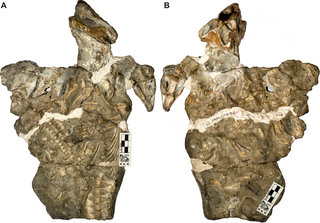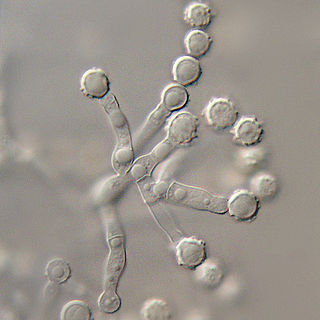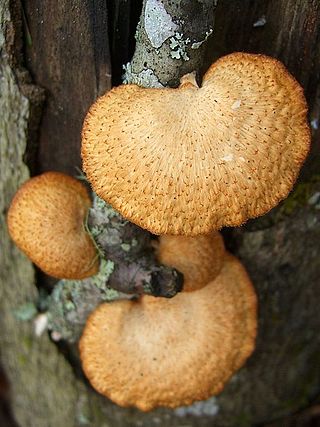The hymenium is the tissue layer on the hymenophore of a fungal fruiting body where the cells develop into basidia or asci, which produce spores. In some species all of the cells of the hymenium develop into basidia or asci, while in others some cells develop into sterile cells called cystidia (basidiomycetes) or paraphyses (ascomycetes). Cystidia are often important for microscopic identification. The subhymenium consists of the supportive hyphae from which the cells of the hymenium grow, beneath which is the hymenophoral trama, the hyphae that make up the mass of the hymenophore.

Galesaurus is an extinct genus of carnivorous cynodont therapsid that lived between the Induan and the Olenekian stages of the Early Triassic in what is now South Africa. It was incorrectly classified as a dinosaur by Sir Richard Owen in 1859.

Sigillaria is a genus of extinct, spore-bearing, arborescent lycophyte, known from the Carboniferous and Permian periods. It is related to the more famous Lepidodendron, and more distantly to modern quillworts.

Microascus is a genus of fungi in the family Microascaceae.

Lentinus brumalis is an inedible species of fungus in the family Polyporaceae. Its common name is the winter polypore. The epithet brumalis means "occurring in the winter", describing how this species tends to fruit during winter. It causes white rot on dead hardwood, and is distributed throughout the Northern Hemisphere in temperate and boreal zones.
Galendromimus is a genus of mites in the Phytoseiidae family.
Ologamasidae is a family of mites in the order Mesostigmata. There are more than 40 genera and 470 described species in Ologamasidae.
Antennolaelaps is a genus of mites in the family Ologamasidae.
Zygoseius is a genus of mites in the superfamily Eviphidoidea. There are about nine described species in Zygoseius.
Antennolaelaps affinis is a species of mite in the family Ologamasidae.
Antennolaelaps brevisetae is a species of mite in the family Ologamasidae.
Antennolaelaps testudo is a species of mite in the family Ologamasidae.
Zygoseius alveolaris is a species of mite in the family Pachylaelapidae.

Neofavolus is a genus of four species of polypore fungi in the family Polyporaceae. All four known species of Neofavolus are known from temperate regions and unknown from the tropics. Neofavolus alveolaris, the type species, is widely distributed in the temperate areas of the Northern Hemisphere, while N. cremeoalbidus and N. mikawai are known only from limited areas of eastern Asia. The most recent addition to the genus, N. suavissimus, is found in North America, Europe, and Japan.

Adolf Pansch was a German anatomist and naturalist.

The Kimmswick Limestone is an Ordovician geologic formation in Arkansas, Illinois and Missouri. Fossils occurring in the Kimmswick include corals, bryozoans, brachiopods, conodonts, trilobites, crinoids and mollusks.
Ammitocyon is a genus of large sized carnivoran mammals, belonging to the Amphicyonidae, that lived during the Late Miocene in what is now Spain. It is notable for its extreme adaptations towards hypercarnivory, its extremely robust skeleton, and was one of the last surviving members of its family.






